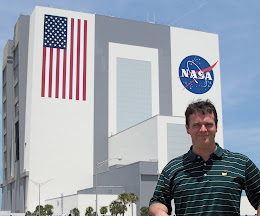An Ariane 5 rocket lifted-off on Wednesday carrying two communications satellites into earth orbit to service North America and the Middle East.
Launch of the sixtieth flight of an Ariane 5 occurred on time at 5:38:07 p.m. EDT, from the Guiana Space Centre in Kourou. It was also the fifth and final Ariane flight of the year as Arianespace turns their attention to launching Russia's Soyuz 2 rocket in October and December.
The launch was delayed one day due to a surprise union labor strike at the launch site within the company Telespazio, which handles the prelaunch processing of Ariane.
Ariane's countdown was flawless as clocks neared it's sunset departure.
Twin solid rocket boosters ignited lift-off combined with a Vulcain 2 core liquid fueled main engine to send the white rocket eastward out over the central Atlantic ocean.
As the 165-foot tall Ariane traveled higher and faster, the boosters then finished their job a little over two minutes after launch and separated as the rocket soared 43 miles high.
Meanwhile, the main engine continued it's nine minute burn.
The rocket's protective payload fairing was jettisoned three minutes into flight as it moved into the upper atmosphere.
The core engine then shutdown six minutes later at an altitude of 116 miles, and the first stage separated seconds later. The second stage's HM-7B engine then fired up for the next few minutes.
The first payload to be deployed was that of Arabsat 5C which rode to orbit on the top of the two satellite stack.
Built by Thales Alenia Space and Europe’s EADS Astrium, the Arabsat 5C will be used for both private and government communications using both Ka-Band and C-band range.
Thales Alenia Space designed and constructed nearly fifty percent of the International Space Station's living area for the crew; and, the European Automated Transfer Vehicles which delivered supplies to the outpost from Kourou.
The satellite is intended to operate for nearly 15 years from a position of 20 degrees East providing communications from north Africa and the Middle East region.
Arabsat 5C separated from the upper stage at 6:05 p.m., at an altitude of 605 miles.
Ariane's second payload, the Orbital Sciences built SES-2 will support both high definition television and communications for North America and the Caribbean over a planned 15 years.
SES-2 then separated and flew free at 6:14 p.m. from an altitude of 1,725 miles.
Once on orbit 22,300 miles above a position at 82 degrees East over the equator, the nearly 78-foot long satellite will undergo a few weeks of testing before becoming operational.
Next up for Arianespace will be the inaugural launch of a Soyuz rocket from Kourou.
The Soyuz launch complex is located seven miles northwest of the Ariane complex, and is mostly based on the configuration of Russia's Soyuz launch pad in Kazakhstan.
The first launch of the Soyuz 2 is planned for just after sunrise on October 20, with a pair of European Galileo navigation satellites.
Arianespace then hopes to get a second Soyuz off the ground before 2011 concludes.
As the 165-foot tall Ariane traveled higher and faster, the boosters then finished their job a little over two minutes after launch and separated as the rocket soared 43 miles high.
Meanwhile, the main engine continued it's nine minute burn.
The rocket's protective payload fairing was jettisoned three minutes into flight as it moved into the upper atmosphere.
The core engine then shutdown six minutes later at an altitude of 116 miles, and the first stage separated seconds later. The second stage's HM-7B engine then fired up for the next few minutes.
The first payload to be deployed was that of Arabsat 5C which rode to orbit on the top of the two satellite stack.
Built by Thales Alenia Space and Europe’s EADS Astrium, the Arabsat 5C will be used for both private and government communications using both Ka-Band and C-band range.
Thales Alenia Space designed and constructed nearly fifty percent of the International Space Station's living area for the crew; and, the European Automated Transfer Vehicles which delivered supplies to the outpost from Kourou.
The satellite is intended to operate for nearly 15 years from a position of 20 degrees East providing communications from north Africa and the Middle East region.
Arabsat 5C separated from the upper stage at 6:05 p.m., at an altitude of 605 miles.
Ariane's second payload, the Orbital Sciences built SES-2 will support both high definition television and communications for North America and the Caribbean over a planned 15 years.
SES-2 then separated and flew free at 6:14 p.m. from an altitude of 1,725 miles.
Once on orbit 22,300 miles above a position at 82 degrees East over the equator, the nearly 78-foot long satellite will undergo a few weeks of testing before becoming operational.
Next up for Arianespace will be the inaugural launch of a Soyuz rocket from Kourou.
The Soyuz launch complex is located seven miles northwest of the Ariane complex, and is mostly based on the configuration of Russia's Soyuz launch pad in Kazakhstan.
The first launch of the Soyuz 2 is planned for just after sunrise on October 20, with a pair of European Galileo navigation satellites.
Arianespace then hopes to get a second Soyuz off the ground before 2011 concludes.
Several Ariane 5 flights in 2012 will deploy several satellites and a European cargo craft bound for the space station in February.
(Charles Atkeison reports on aerospace, science & technology. Follow his updates via Twitter @AbsolutSpaceGuy.)





